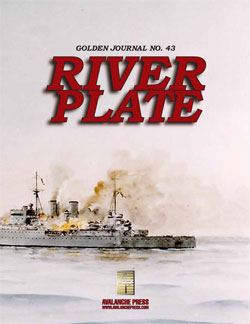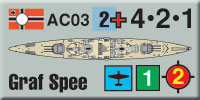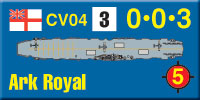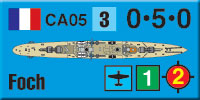| Golden Journal No. 43:
SWWAS: River Plate
Publisher’s Preview
by Mike Bennighof, Ph.D.
April 2024
 Games are supposed to be fun, at least to play. They’re usually fun to design, but not always. The Golden Journal, however, is the designer’s playground – it’s always fun to make. It’s just a little thing, a booklet with a nice cover and a strip of new playing pieces (die-cut and silky-smooth, just like the ones we put into the games). Usually, it takes on an odd topic of alternative history, or sometimes an even odder topic of actual history. Games are supposed to be fun, at least to play. They’re usually fun to design, but not always. The Golden Journal, however, is the designer’s playground – it’s always fun to make. It’s just a little thing, a booklet with a nice cover and a strip of new playing pieces (die-cut and silky-smooth, just like the ones we put into the games). Usually, it takes on an odd topic of alternative history, or sometimes an even odder topic of actual history.
Golden Journal No. 43: River Plate breaks that mold by more than a little. It’s not just about a thing that really happened, but a reasonably famous thing that really happened. In September 1939, the German armored cruiser (popularly called a “pocket battleship”) Admiral Graf Spee set out for the South Atlantic to raid Allied shipping. Over the next three months she sank nine merchant ships for a total of just over 50,000 tons.
In December, Admiral Graf Spee steamed for the estuary of the River Plate, a heavily-trafficked area where ships loaded beef and grain at Buenos Aires and other Argentine ports for shipment to Europe. Seeking a convoy thought to be assembling there, Admiral Graf Spee instead found three British cruisers. After shooting up two of them but suffering damage in return, the ship pulled into neutral Montevideo, Uruguay. Her captain decided to scuttle her rather than fight again or try to make it home (or even to a much-friendlier neutral port in Argentina). The cruiser’s luck held, and she settled in about 11 meters of water – she drew 7.6 meters, which meant that the waves barely reached her main deck. The British would later buy the wreck from the Germans, by way of a Uruguayan front company, and strip her of all sensitive gear including her radar.
 Despite the rather anti-climactic ending, the search for the Admiral Graf Spee provided a great deal of drama during the so-called “Phony War” in the fall and winter of 1939. The British deployed a number of heavy units far away from the main theater of war, which was the whole purpose in sending Admiral Graf Spee to the South Atlantic, and even brought along some of their French allies. The heavy ships were not the end of the German cruiser; she was done in by the very ships she had been designed to out-class, but the British went “right at her” in the Nelson tradition and despite grievous damage that could easily have sunk two of the three cruisers (which would have meant the third would have followed shortly), they came out with an improbably victory. That’s the “Heart of Oak” special rule found in many Second World War at Sea games in action. Despite the rather anti-climactic ending, the search for the Admiral Graf Spee provided a great deal of drama during the so-called “Phony War” in the fall and winter of 1939. The British deployed a number of heavy units far away from the main theater of war, which was the whole purpose in sending Admiral Graf Spee to the South Atlantic, and even brought along some of their French allies. The heavy ships were not the end of the German cruiser; she was done in by the very ships she had been designed to out-class, but the British went “right at her” in the Nelson tradition and despite grievous damage that could easily have sunk two of the three cruisers (which would have meant the third would have followed shortly), they came out with an improbably victory. That’s the “Heart of Oak” special rule found in many Second World War at Sea games in action.
We included a pair of scenarios for the Admiral Graf Spee’s adventure in our long out-of-print Cone of Fire game, but I was eager for the chance to tackle the topic again. Our alternative history game Tropic of Capricorn uses one map from the old Cone of Fire, and the expansion Tropical Storm has another (the third isn’t necessary for the Admiral Graf Spee scenarios). The ships and aircraft needed just barely fit in the space available for a Golden Journal, with the help of a little creative die-cutting; the standard Second World War at Sea stuff (rules, tactical map, task force markers) comes out of Tropic of Capricorn.
 The old Cone of Fire pre-dated the story-arc format we use in our games now, and I wanted the chance to apply it to the search for Admiral Graf Spee. We look not just at the full scope of her South Atlantic cruise (which was the focus of the old operational scenario) and the Battle of the River Plate (the battle scenario). We have new versions of those, but as we’ve done in more recent Second World War at Sea games like Midway Deluxe, we break down the action with short scenarios that pick up at key points in the narrative. The old Cone of Fire pre-dated the story-arc format we use in our games now, and I wanted the chance to apply it to the search for Admiral Graf Spee. We look not just at the full scope of her South Atlantic cruise (which was the focus of the old operational scenario) and the Battle of the River Plate (the battle scenario). We have new versions of those, but as we’ve done in more recent Second World War at Sea games like Midway Deluxe, we break down the action with short scenarios that pick up at key points in the narrative.
That lets us tell the story (in this case of the Admiral Graf Spee’s final voyage) through the scenarios; I’ve come to appreciate the ability of a board game to tell a story, weaving the narrative through the scenarios. We did that here, and it’s a fairly pitiful story for the vaunted “pocket battleship,” and a triumphant one for the Royal Navy.
The British had learned a great deal from the First World War, and in particular had abandoned the “cult of the senior officer.” Commodore Henry Harwood commanded four cruisers (one of them absent for repairs) and had a hunch that the German ship would appear off the River Plate, a true target-rich environment. He had the authority to go there, rather than wait for the Admiralty and the ever-meddling Winston Churchill to micro-manage his squadron, and when he saw the enemy, he did not wait for permission but attacked immediately. These were not the same British the Germans had fought in the 1914-1918 war.
 The German commander, Captain Hans Langsdorff, knew better than to trust the hype surrounding his ship. The “pocket battleship” was not; it was a long-range cruiser built to sink defenseless merchantmen, not to fight enemy warships. Even so, Langsdorff accepted battle, only to belatedly realize that Harwood was willing to sacrifice all three of his cruisers to damage Admiral Graf Spee badly enough to make her easy prey for other Allied forces. By the time he realized his error, it was much too late. The German commander, Captain Hans Langsdorff, knew better than to trust the hype surrounding his ship. The “pocket battleship” was not; it was a long-range cruiser built to sink defenseless merchantmen, not to fight enemy warships. Even so, Langsdorff accepted battle, only to belatedly realize that Harwood was willing to sacrifice all three of his cruisers to damage Admiral Graf Spee badly enough to make her easy prey for other Allied forces. By the time he realized his error, it was much too late.
Did he have other options? In Second World War at Sea: River Plate, he does and we can explore them. He can bring out his damaged cruiser for another go at the damaged British (who may or may not have been reinforced). He can make a run for Argentina. He can run for home. And we also look at the possibilities of Argentine cruisers coming out to help (this was not even remotely likely, but the pieces are right there in Tropic of Capricorn so it seems silly not to use them).
Second World War at Sea: River Plate is a tiny expansion set, but it deals with an actual well-known event and it turns an alternative-history game into one of actual history. The new pieces have all-new artwork, to make full use of the incredible reproduction of our new printing process, and are smooth on both sides thanks to 21st-Century die-cutting technology. This little expansion set meets the same standards of historical and narrative depth as our much larger products, which makes it a very satisfying project for me, here in the designer’s playground.
The Golden Journal is only available to the Gold Club (that’s why we call it the Golden Journal).
Click here to join the Gold Club.
See your Gold Club Insider newsletter for ordering information.
Sign up for our newsletter right here. Your info will never be sold or transferred; we'll just use it to update you on new games and new offers.
Mike Bennighof is president of Avalanche Press and holds a doctorate in history from Emory University. A Fulbright Scholar and NASA Journalist in Space finalist, he has published a great many books, games and articles on historical subjects; people are saying that some of them are actually good.
He lives in Birmingham, Alabama with his wife, three children, and new puppy. He misses his lizard-hunting Iron Dog, Leopold. Leopold was a good dog.
Want to keep Daily Content free of third-party ads? You can send us some love (and cash) through this link right here.
|
